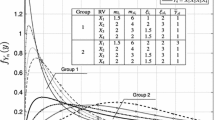Abstract
Suzuki distribution is a popular model in wireless communications. In this paper, a generalization of it is proposed and two moment estimates derived. The performance of the estimates is assessed by simulation. Finally, applications are discussed for two problems in wireless communications.
Similar content being viewed by others
References
Alouini M. S., Goldsmith A. J. (2000) Adaptive modulation over Nakagami fading channels. Wireless Personal Communications 13: 119–143
Babalis P. G., Trakadas P. T., Capsalis C. N. (2002) A maximum likelihood decoding algorithm for wireless channels. Wireless Personal Communications 23: 283–295
Coulson A. J., Williamson A. G., Vaughan R. G. (1998) An improved fading distribution for mobile radio. IEE Proceedings of Communications 145: 197–202
Hashemi H. (1993) The indoor radio propagation channel. Proceedings of the IEEE 81: 943–968
Johnson N. L., Kotz S. (1970) Continuous univariate distributions, Vol. 1. Houghton Miflin Company, Boston
Karadimas P., Kotsopoulos S. A. (2008) A generalized modified Suzuki model with sectored and inhomogeneous diffuse scattering component. Wireless Personal Communications 47: 449–469
Khalighi M. A., Raoof K., Jourdain G. (2002) Capacity of wireless communication systems employing antenna arrays, a tutorial study. Wireless Personal Communications 23: 321–352
Nadarajah S., Kotz S. (2007) A class of generalized models for shadowed fading channels. Wireless Personal Communications 43: 1113–1120
Nielsen J. O., Afanassiev V., Andersen J. B. (2001) A dynamic model of the indoor channel. Wireless Personal Communications 19: 91–120
Oh S. W., Li K. H. (2001) Performance evaluation for forward-link cellular DS-CDMA over frequency-selective Nakagami multipath fading channels. Wireless Personal Communications 18: 275–287
Polydorou D. S., Capsalis C. N. (1997) A new theoretical model for the prediction of rapid fading variations in an indoor environment. IEEE Transactions on Vehicular Technology 46: 748–754
Rafiq G., Patzold M. (2009) A study of the influence of shadowing on the statistical properties of the capacity of mobile radio channels. Wireless Personal Communications 50: 5–18
Shankar P. M. (2004) Error rates in generalized shadowed fading channels. Wireless Personal Communications 28: 233–238
Shankar P. M. (2006) Performance analysis of diversity combining algorithms in shadowed fading channels. Wireless Personal Communications 37: 61–72
Siqueira G. L., Vasquez E. J. A. (2000) Local and global signal variability statistics in a mobile urban environment. Wireless Personal Communications 15: 61–78
Stacy E. W., Mihram G. A. (1965) Parameter estimation for a generalized gamma distrition. Technometrics 7: 349–358
Suzuki H. (1977) A statistical model for urban radio propagation. IEEE Transactions on Communications COM-25: 673–680
Vellis F. E., Capsalis C. N. (2000) A model for the statistical characterization of fast fading in the presence of a user. Wireless Personal Communications 15: 207–219
Yang Y. P., Jong S. L., Liu J. C., Liu C. H. (2003) Performance of up-link MC-CDMA system with frequency offset and imperfect channel estimation simultaneously over Nakagami fading channels. Wireless Personal Communications 27: 247–265
Yilmaz F., Kucur O. (2009) Symbol error rate performance of QS-CDMA over frequency selective time non-selective multipath generalized gamma fading channels. Wireless Personal Communications 49: 487–516
Author information
Authors and Affiliations
Corresponding author
Rights and permissions
About this article
Cite this article
Withers, C.S., Nadarajah, S. A Generalized Suzuki Distribution. Wireless Pers Commun 62, 807–830 (2012). https://doi.org/10.1007/s11277-010-0095-4
Published:
Issue Date:
DOI: https://doi.org/10.1007/s11277-010-0095-4




